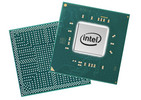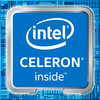Intel Celeron N4000 vs Intel Celeron J4105
Intel Celeron N4000
► remove from comparison
The Intel Celeron N4000 is a dual-core SoC designed for affordable laptops and mini-PCs and was announced late 2017. It runs at 1.1 GHz to 2.6 GHz (Single Core Burst, Multi Core Burst maxes out at 2.5 GHz) and is based on the Gemini Lake platform. Similar to the Apollo Lake predecessor, the chip is manufactured on a 14 nm process with FinFETs but offers slightly improved processor cores, double the amount of L2 cache, all in a smaller package. Partial Wi-Fi 5 support is baked into the chip. Besides two CPU cores, the chip also includes a DirectX 12 capable GPU as well as a DDR4/LPDDR4 memory controller (dual-channel, up to 2400 MHz). The SoC is not replaceable as it is directly soldered to the mainboard.
Architecture
The processor architecture was slightly reworked and is now called Goldmont Plus. It features a larger L2 cache (4 MB). That means the per-clock-performance should be a bit better, but not anywhere near the Core CPUs like Kaby Lake Y.
Performance
The average N4000 in our database only just matches the Core i5-4300Y, a fairly old dual-core processor of nearly the same energy efficiency, in multi-thread performance. In other words, the Celeron is a very slow processor that's good enough for the most basic of tasks only. Expect long load times no matter the app.
Graphics
The UHD Graphics 600 (Gemini Lake) is based on Intel's Generation 9 architecture, which supports DirectX 12 and is also used for the Kaby Lake / Skylake / Apollo Lake graphics adapters (like HD Graphics 520). Equipped with 12 EUs and a clock of up to 650 MHz, the performance should be roughly on par with the older HD Graphics 500 (Apollo Lake).
The chip also includes an advanced video engine with hardware support for the playback of VP9 and H.265 (8-bit color-depth).
Power consumption
Like most other N-class Intel chips, the Celeron N4000 has a 6 W TDP (also known as the long-term power limit). This is not much at all, allowing laptop makers to build passively cooled laptops, tablets, mini-PCs around the chip. The SoC can briefly consume up to 15 W, though, depending on how a system is configured.
Last but not the least, this Celeron is manufactured on one of the old 14 nm Intel processes leading to poor, as of early 2023, energy efficiency.
Intel Celeron J4105
► remove from comparison
The Intel Celeron J4105 is a quad-core desktop SoC primarily for mini PCs and mini ITX mainboards. It runs at 1.5 - 2.5 GHz (Single Core Burst) and is based on the Gemini Lake platform. Similar to the Apollo Lake predecessor, the chip is manufactured in a 14 nm process with FinFETs but offers slightly improved processor cores, double the amount of L2 cache, a smaller package, a new generation of monitor outputs (Gen 10) and a partly integrated WiFi chip. Besides four CPU cores, the chip also includes a DirectX 12 capable GPU as well as a DDR4/LPDDR4 memory controller (dual-channel, up to 2400 MHz). The SoC is not replaceable as it is directly soldered to the mainboard.
Architecture
The processor architecture was slightly reworked and is now called Goldmont Plus. It features an increased level 2 cache (to 4 MB). That means the per-clock-performance should be a bit better, but not near the Core CPUs like Kaby Lake Y.
Performance
While we have not tested a single system built around the J4105 as of August 2023, we have tested a certain number of laptops featuring the Celeron N4120, a chip with very similar specs (4 cores, 4 threads, up to 2.6 GHz). Based on that, expect the J4105 to be very slow in all but the most basic activities.
| Model | Intel Celeron N4000 | Intel Celeron J4105 | ||||||||||||||||||||||||||||||||||||||||||||||||
| Codename | Gemini Lake | Gemini Lake | ||||||||||||||||||||||||||||||||||||||||||||||||
| Series | Intel Gemini Lake | Intel Gemini Lake | ||||||||||||||||||||||||||||||||||||||||||||||||
| Series: Gemini Lake Gemini Lake |
|
| ||||||||||||||||||||||||||||||||||||||||||||||||
| Clock | 1100 - 2600 MHz | 1500 - 2500 MHz | ||||||||||||||||||||||||||||||||||||||||||||||||
| L2 Cache | 4 MB | 4 MB | ||||||||||||||||||||||||||||||||||||||||||||||||
| Cores / Threads | 2 / 2 | 4 / 4 | ||||||||||||||||||||||||||||||||||||||||||||||||
| TDP | 6 Watt | 10 Watt | ||||||||||||||||||||||||||||||||||||||||||||||||
| Technology | 14 nm | 14 nm | ||||||||||||||||||||||||||||||||||||||||||||||||
| max. Temp. | 105 °C | 105 °C | ||||||||||||||||||||||||||||||||||||||||||||||||
| Socket | BGA1090 | BGA1090 | ||||||||||||||||||||||||||||||||||||||||||||||||
| Features | DDR4-2400/LPDDR4-2400 RAM, PCIe 2, MMX, SSE, SSE2, SSE3, SSSE3, SSE4.1, SSE4.2, SMEP, SMAP, MPX, EIST, TM1, TM2, Turbo, AES-NI, RDRAND, RDSEED, SHA, SGX | DDR4-2400/LPDDR4-2400 RAM, PCIe 2, MMX, SSE, SSE2, SSE3, SSSE3, SSE4.1, SSE4.2, VMX, SMEP, SMAP, MPX, EIST, TM1, TM2, Turbo, AES-NI, RDRAND, RDSEED, SHA, SGX | ||||||||||||||||||||||||||||||||||||||||||||||||
| iGPU | Intel UHD Graphics 600 (200 - 650 MHz) | Intel UHD Graphics 600 (250 - 750 MHz) | ||||||||||||||||||||||||||||||||||||||||||||||||
| Architecture | x86 | x86 | ||||||||||||||||||||||||||||||||||||||||||||||||
| $107 U.S. | $107 U.S. | |||||||||||||||||||||||||||||||||||||||||||||||||
| Announced | ||||||||||||||||||||||||||||||||||||||||||||||||||
| Manufacturer | ark.intel.com | ark.intel.com |
Benchmarks
Average Benchmarks Intel Celeron N4000 → 100% n=2
Average Benchmarks Intel Celeron J4105 → 149% n=2
* Smaller numbers mean a higher performance
1 This benchmark is not used for the average calculation













